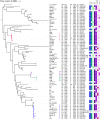Horsing around: Escherichia coli ST1250 of equine origin harbouring epidemic IncHI1/ST9 plasmid with bla CTX-M-1 and an operon for short-chain fructooligosaccharides metabolism
- PMID: 33619063
- PMCID: PMC8092906
- DOI: 10.1128/AAC.02556-20
Horsing around: Escherichia coli ST1250 of equine origin harbouring epidemic IncHI1/ST9 plasmid with bla CTX-M-1 and an operon for short-chain fructooligosaccharides metabolism
Abstract
The relatedness of the equine-associated Escherichia coli ST1250 and its single- and double-locus variants (ST1250-SLV/DLV), obtained from horses in Europe, was studied by comparative genome analysis. A total of 54 isolates of E. coli ST1250 and ST1250-SLV/DLV from healthy and hospitalized horses across Europe [Czech Republic (n=23), the Netherlands (n=18), Germany (n=9), Denmark (n=3) and France (n=1)] from 2008-2017 were subjected to whole-genome sequencing. An additional 25 draft genome assemblies of E. coli ST1250 and ST1250-SLV/DLV were obtained from the public databases. The isolates were compared for genomic features, virulence genes, clade structure and plasmid content. The complete nucleotide sequences of eight IncHI1/ST9 and one IncHI1/ST2 plasmids were obtained using long-read sequencing by PacBio or MinION. In the collection of 79 isolates, only 10 were phylogenetically close (<8 SNP). The majority of isolates belonged to phylogroup B1 (73/79, 92.4%) and carried bla CTX-M-1 (58/79, 73.4%). The plasmid content of the isolates was dominated by IncHI1 of ST9 (56/62, 90.3%) and ST2 (6/62, 9.7%), while 84.5% (49/58) bla CTX-M-1 genes were associated with presence of IncHI1 replicon of ST9 and 6.9% (4/58) with IncHI1 replicon of ST2 within the corresponding isolates. The operon for the utilization of short chain fructooligosaccharides (fos operon) was present in 55 (55/79, 69.6%) isolates, and all of these carried IncHI1/ST9 plasmids. The eight complete IncHI1/ST9 plasmid sequences showed the presence of bla CTX-M-1 and the fos operon within the same molecule. Sequences of IncHI1/ST9 plasmids were highly conserved (>98% similarity) regardless of country of origin and varied only in the structure and integration site of MDR region. E. coli ST1250 and ST1250-SLV/DLV are phylogenetically-diverse strains associated with horses. A strong linkage of E. coli ST1250 with epidemic multi-drug resistance plasmid lineage IncHI1/ST9 carrying bla CTX-M-1 and the fos operon was identified.
Copyright © 2021 American Society for Microbiology.
Figures



References
-
- Ewers C, Bethe A, Semmler T, Guenther S, Wieler LH. 2012. Extended-spectrum β-lactamase-producing and AmpC-producing Escherichia coli from livestock and companion animals, and their putative impact on public health: a global perspective. Clin Microbiol Infect 18:646–655. 10.1111/j.1469-0691.2012.03850.x. - DOI - PubMed
-
- McNulty C, Lecky DM, Xu-McCrae L, Nakiboneka-Ssenabulya D, Chung KT, Nichols T, Thomas HL, Thomas M, Alvarez-Buylla A, Turner K, Shabir S, Manzoor S, Smith S, Crocker L, Hawkey PM. 2018. CTX-M ESBL-producing Enterobacteriaceae: estimated prevalence in adults in England in 2014. J Antimicrob Chemother 73:1368–1388. 10.1093/jac/dky007. - DOI - PMC - PubMed
-
- Dolejska M, Duskova E, Rybarikova J, Janoszowska D, Roubalova E, Dibdakova K, Maceckova G, Kohoutova L, Literak I, Smola J, Cizek A. 2011. Plasmids carrying blaCTX-M-1 and qnr genes in Escherichia coli isolates from an equine clinic and a horseback riding centre. J Antimicrob Chemother 66:757–764. 10.1093/jac/dkq500. - DOI - PubMed
LinkOut - more resources
Full Text Sources
Other Literature Sources

